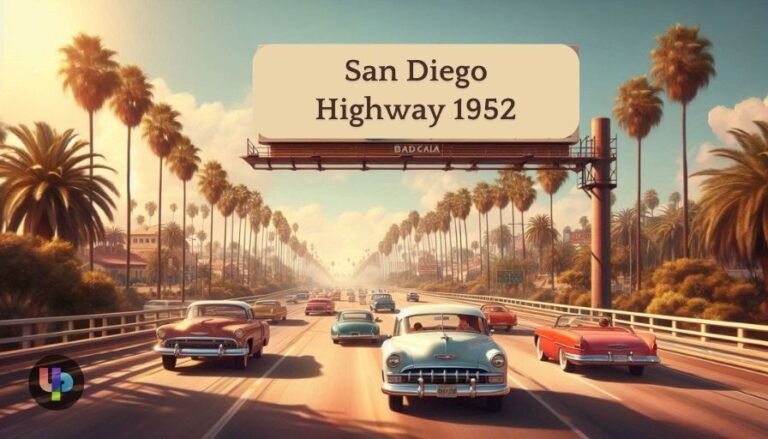The development of San Diego’s highway infrastructure in the 1950s was a critical moment in the city’s expansion and modernization. San Diego Highway 1952, a key component of this growth, connected various parts of the city and surrounding areas, helping to foster economic development and improving access for residents and businesses alike. This article explores the historical importance of San Diego Highway 1952, its construction, and its lasting impact on the region.
The Origins of San Diego Highway 1952
In the early 1950s, San Diego experienced rapid population growth, largely due to post-World War II suburbanization. With more residents and businesses settling in the city, the demand for a more comprehensive and efficient transportation network became evident. San Diego Highway 1952 was part of a statewide effort to improve roadways and facilitate easier travel between major cities and suburban developments. The construction of this highway was not only necessary for local commutes but also contributed to the city’s overall connectivity with the rest of Southern California.
1952: A Pivotal Year for Infrastructure
1952 was a landmark year for San Diego’s infrastructure. During this time, the city prioritized the development of highways that would cater to the growing needs of residents and businesses. San Diego Highway 1952 played a central role, connecting downtown San Diego to expanding suburban areas. This roadway allowed commuters to access new residential developments, which were being built rapidly to accommodate the post-war population boom. The highway also provided critical support to businesses by facilitating the transport of goods and services.
Evolution of San Diego Highway 1952
Over time, San Diego Highway 1952 evolved to meet the growing demands of the city. Initially, the highway was a relatively simple route, but as traffic increased, it became clear that expansions and upgrades were necessary.
Upgrades and Expansions
By the 1970s, the highway had undergone significant improvements to address the increased volume of vehicles. Engineers widened the lanes and added more exit ramps to improve traffic flow and accessibility. These upgrades were crucial in ensuring the continued efficiency of the highway as San Diego’s population grew. Despite these changes, some elements of the original design of San Diego Highway 1952 are still visible today, serving as a reminder of the city’s early infrastructure efforts.
Integration into Larger Highway Systems
As San Diego’s highway system expanded, San Diego Highway 1952 became part of broader transportation networks, including U.S. Route 80 and Highway 395. These major highways were vital in linking San Diego to other key cities like Los Angeles and beyond. The integration of San Diego Highway 1952 into these larger routes further cemented its importance, not just locally but regionally as well. This incorporation facilitated better transportation for both personal travel and commerce, solidifying San Diego’s role as a critical hub in Southern California.
Economic and Cultural Impact
Boost to Local Economies
The construction of San Diego Highway 1952 had a profound effect on the local economy. By improving accessibility, the highway opened new opportunities for businesses, especially those located along the route. Shops, restaurants, and service providers saw increased traffic as commuters and travelers passed through these areas. This uptick in business activity was especially beneficial to suburban areas that were previously difficult to reach, turning them into bustling commercial hubs. Over time, these developments contributed to San Diego’s broader economic growth, as the city became more interconnected.
Cultural Significance
The cultural impact of San Diego Highway 1952 cannot be overlooked. The highway was constructed during a period of significant change in American society, particularly in terms of mobility and suburbanization. The highway represented the freedom of movement that characterized the 1950s and 1960s, a time when car culture was becoming increasingly prominent. It also symbolized the connection between urban centers and suburban developments, fostering the growth of residential areas outside the downtown core.
Environmental Considerations
The construction of San Diego Highway 1952, like many infrastructure projects of its time, came with environmental consequences. In the 1950s, environmental regulations were not as stringent as they are today, and highway construction often disrupted local ecosystems. The rapid expansion of San Diego’s road network resulted in habitat loss and changes in land use, particularly in rural areas that were being developed into suburban neighborhoods.
Modern Environmental Reflections
Today, the legacy of San Diego Highway 1952 includes a greater awareness of the environmental impact of large infrastructure projects. Modern highway developments in San Diego and elsewhere are conducted with a greater emphasis on sustainability. Eco-friendly materials, habitat preservation, and minimizing environmental disruption are now key considerations in infrastructure planning. The lessons learned from the construction of San Diego Highway 1952 continue to inform the city’s approach to modern road development.
The Future of San Diego’s Highway System
As San Diego continues to grow, the city’s highway system will need to evolve to meet future demands. San Diego Highway 1952 provides a model for future projects, illustrating the importance of infrastructure in supporting population growth and economic development. Today, modern technologies such as smart traffic management systems and electric vehicle lanes are being integrated into new highway designs. These innovations will help San Diego stay ahead of transportation challenges as the city’s population increases and its infrastructure ages.
Conclusion
San Diego Highway 1952 played a critical role in shaping the city’s development during a pivotal time in its history. From facilitating suburban expansion to boosting local businesses, the highway has had a lasting impact on San Diego’s economic and cultural landscape. While it may no longer be the major thoroughfare it once was, its legacy lives on in the city’s modern infrastructure. As San Diego looks to the future, the lessons learned from the development of San Diego Highway 1952 will continue to guide the city’s approach to building efficient and sustainable roadways.
